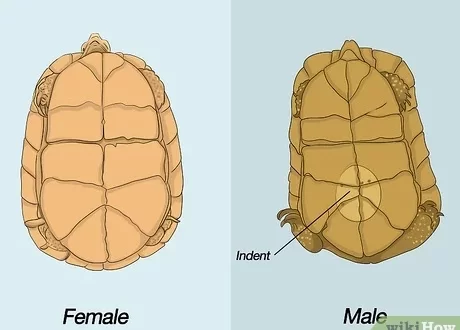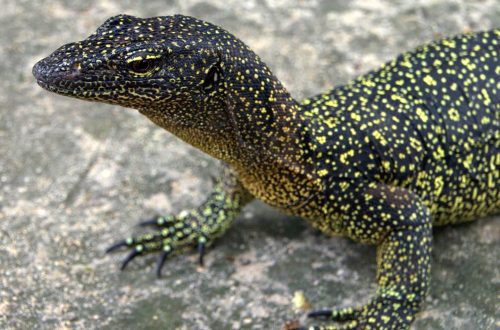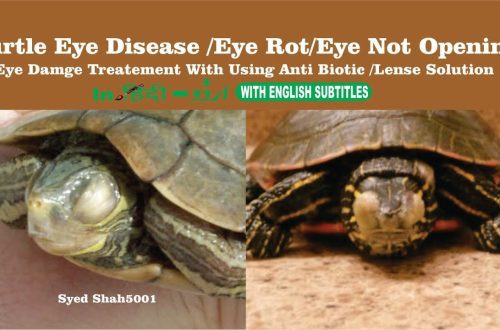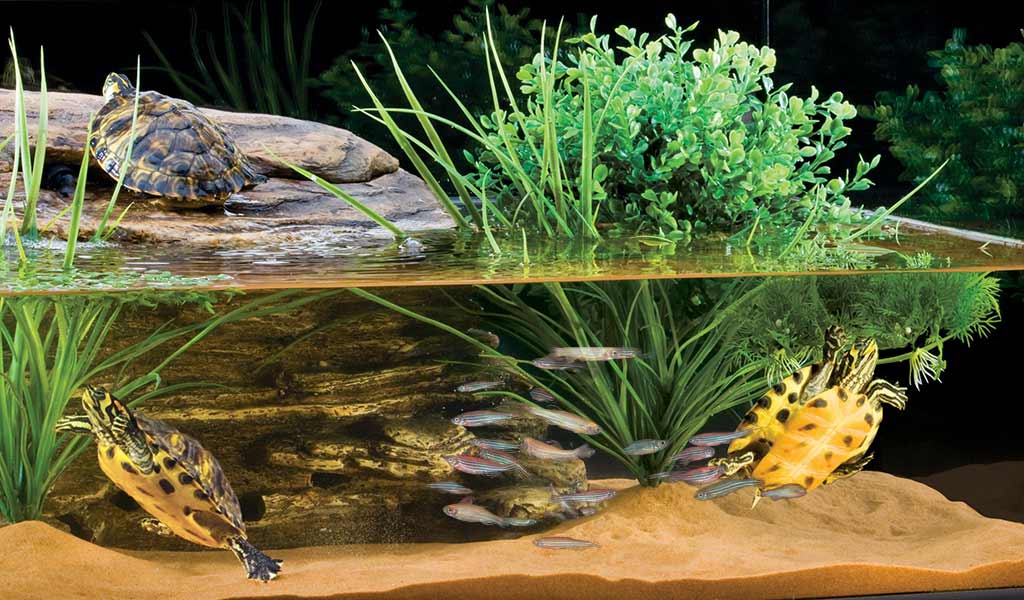
What do aquatic turtles eat at home, what can you feed small decorative aquarium turtles and what not
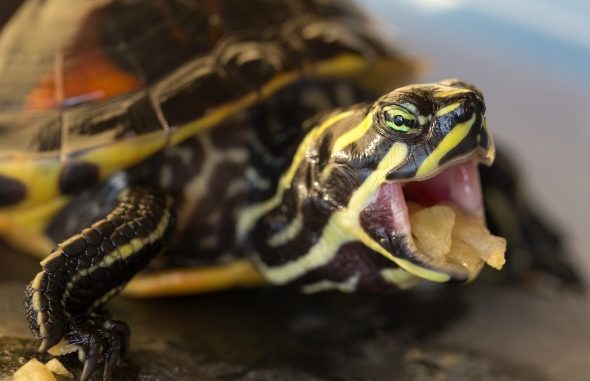
Water turtles in their natural habitat feed mainly on animal food. Red-eared live in fresh ponds and lakes. In their native waters, insects and larvae, mollusks, small crustaceans and medium-sized fish are available to reptiles. You need to feed a small decorative aquatic turtle at home in such a way as to bring the pet’s menu as close as possible to the natural diet.
Contents
General requirements
Aquatic decorative turtles eat both animal and vegetable food. Dry food is best combined with natural products. At the age of up to a year, reptiles need one meal a day. During the period of active formation of the body, it is useful for young individuals to eat protein-rich foods, including insects and raw fish. Through a natural diet, useful elements are best absorbed.
An adult aquarium turtle is fed every other day or two. After a year, the content of plant foods in the red-eared menu rises to 50%.
A single portion is determined so that after 30 minutes the pet has completely eaten it. A young turtle usually needs 2-3 pieces of 1 cm³. Adult chunk sizes may be slightly larger. If there is food left in the tank after 30 minutes, the amount of food should be reduced for the next time.
Due to the peculiarities of the esophagus of the domestic aquatic turtle, food for it is not thermally processed. Properly offer your pet food at room temperature. Hot and cold food can cause refusal to eat, or cause illness.
You can feed a small decorative turtle with tweezers, or by leaving food in the aquarium. Some owners teach their pets to eat on land. Most reptiles prefer to take their lunch into the water, which means they need to be changed more often. To keep the aquaterrarium clean for longer, you can feed the aquatic ornamental turtle in a separate container of water.
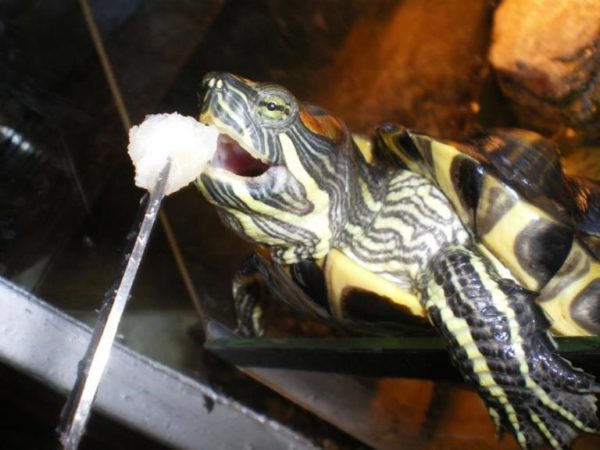
In winter and autumn, reptiles usually eat less frequently, but in large quantities. In summer and spring they prefer to eat less, but more often. There are no special rules for feeding turtles by season. Changes in diet are necessary only for animals that are preparing for and coming out of hibernation.
Harmful and useful products
Small decorative water turtles at home eat only what a person offers. To provide a reptile with a balanced diet, it is necessary to use a varied list of products. Food for aquatic turtles is combined with natural food.
There are situations when at home aquatic turtles eat from a human table. Don’t trust your pet’s tastes. Dry food for other animal species and meals for humans are not suitable for reptiles.
Fish and Seafood
The fauna of freshwater lakes and ponds is a natural food for the domestic aquatic turtle. Low-fat river fish is suitable for reptile food. Small ones can be given with bones and whole entrails. Large fish are crushed, large bones are finely chopped or crushed. Fatty fish such as capelin, sprat, sprat and herring should not be given.
Suitable varieties:
- hake;
- cod;
- perch;
- pollock;
- crucian carp;
- bream.
Aquatic turtles at home eat small crustaceans. The most popular among them is live gammarus and other representatives of the amphipod genus, daphnia.
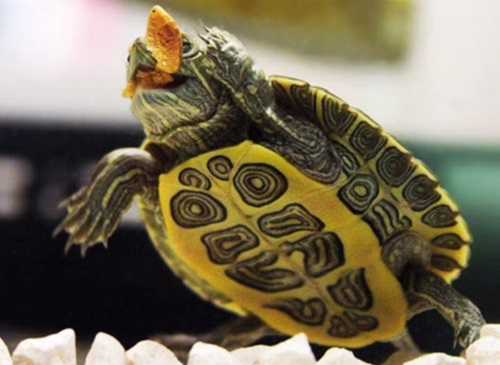
Crabs and shrimp can be given raw. Occasionally, you need to treat your pet with mussels and oysters without shells and octopus tentacles. Many red-eared turtles love squid, but they should not be fed to pets. Reptiles have cloudy eyes from such food.
Meat and offal
The meat of land animals is difficult to digest by the digestive system of reptiles. It is not recommended to feed a small turtle. Even adults should absolutely not be given fatty meats, including pork and lamb. Red-eared turtles should not be offered chicken, either raw or cooked. Beef should not be given either in pieces or in the form of minced meat.
It is strictly forbidden to treat reptiles with factory-made sausages, sausages and pates. Food is not digested, and spices and preservatives have a negative impact on the health of the animal.
To fuel the body with vitamin A, turtles occasionally need to be given beef liver and heart. Reptiles feed exclusively on raw food. Animal proteins after heat treatment are poorly absorbed by the digestive system of a freshwater predator. Red-eared turtles can eat food mice and frogs.

Plant food
The baby turtle should be fed carrots and lettuce if it shows interest in them. With other vegetables, extra care is required. Foods high in oxalates and phosphorus are harmful because they interfere with the absorption of calcium.
It is better to offer freshwater meat-eaters citrus fruits, berries and fruits with caution. One of the safest foods is an apple. Turtles can eat pitted flesh. In limited quantities, pear, banana, melon, watermelon, apricot, raspberries and strawberries can be given. Fruit pits and citrus peel are harmful to red-eared turtles.
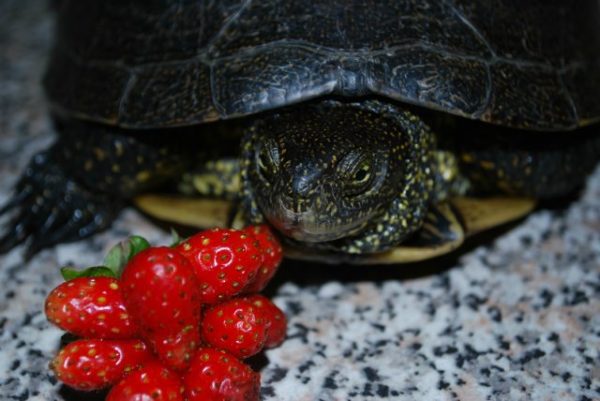
To prevent goiter diseases, products containing goiter should be avoided. They interact with iodine, interfere with its absorption, and contribute to the growth of thyroid tissue. Therefore, red-eared turtles should not be given cabbage, turnips, beans, soybeans and nuts.
Aquatic turtles eat grass plants and algae. Freshwater suitable duckweed, water hyacinth, pistia and hornwort. The list of allowed herbs includes non-poisonous meadow plants, including clover, dandelions and daisies. Many reptiles love germinated barley and oats.
Insects and molluscs
You can feed water turtles with larvae living in the water, including bloodworms and coretra. Terrestrial insects are suitable for food. Often for red-eared turtles, crickets and locusts become a favorite delicacy. Useful in composition are moth, lion fly larva and earthworms. Zofobas must be decapitated before use. Insects can be fed live, dried or frozen.
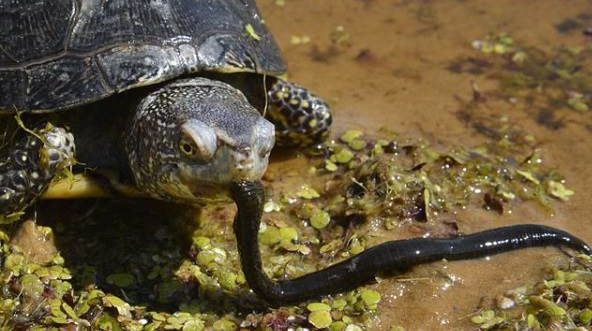
Shellfish are well absorbed by the digestive system of reptiles. Snails can be offered live and defrosted. It is better not to give slugs without shells to turtles, since toxic substances perform a protective function in their body.
Pet treats include:
- coils;
- ampoule;
- physical;
- patient;
- land snails.
It is permissible to treat domestic aquatic turtles with Achatina, which have reached 1-1,5 cm in length.
In terms of composition, maggots are a good food, but once in the stomach of a turtle, they continue the life cycle. Since the larva causes decomposition processes around itself, it can irritate the mucous organs of the reptile. The flour worm contains a lot of fat and few other nutrients, so it is considered useless.
Other products
A turtle that eats from a human table is doomed to disease. It is harmful for reptiles to eat bread, cereals, seasoned and thermally processed dishes. Even crab sticks, which are made from fish waste, are indigestible animal food.
Do not offer turtles dairy products, including cottage cheese. The animal receives calcium from fish bones and chitin shells of insects. Chicken eggs cause flatulence in the red-eared turtle, so they are also banned. Pounded shells from boiled eggs can be used as a source of calcium.
Dry food
If the turtle eats only dried and canned products, it loses vitamins and useful elements. Factory dry food – easy to use, well stored and can serve as one of the dishes in the turtle’s diet. To choose high-quality products, you need to pay attention to the composition.
Many varieties are produced on the basis of dried gammarus, which is difficult for red-eared turtles to digest and contains few nutrients. Among these, it is impossible to choose a dish for the basis of the reptile menu. Admissible occasional use if the turtle receives other food besides food.
examples:
- JBL ProBaby;
- JBL Gammarus;
- Tetra Gammarus;
- Tetra Gammarus Mix;
- Zoomir Torti.
From Tetrafauna, you can pick up mono-feeds, where only one type of food is present in the composition, such as daphnia or grasshoppers. They are convenient to combine with natural food and use as a treat. Canned house crickets can play the same role.
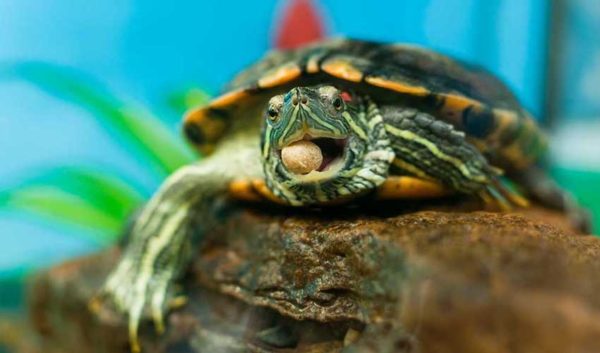
Varieties containing fish and fishmeal are better than gammarus-based feed. The leaders in the manufacture of these are JBL and Tetrafauna. The composition based on fish and shrimp is enriched with larvae and insects. Good mixtures can be used to alternate with natural products, as a complete meal.
examples:
- JBL Agil;
- JBL Schildkrotenfutter;
- JBL Energil;
- Sera Raffy I;
- Sera Raffy Royal;
- Tetra ReptoMin Baby.
Aquatic turtle food may contain dairy products, eggs, brewer’s yeast, colorants and preservatives. Owners should carefully study the label to weed out options with harmful impurities.
live food
It is useful for a turtle living in an aquarium to hunt small fish and snails. Fresh food is more palatable to reptiles and retains maximum nutrients. Snails, fish and larvae can be grown independently and save on factory feed. To do this, you will need a separate container, since live food will not have time to multiply next to the reptile.
The most unpretentious for growing at home are snails. Many mollusks are hermaphrodites; for reproduction, it is enough to place a few individuals in an aquarium. A favorable temperature for breeding is 22-28 ° C; algae, boiled vegetables, rotten leaves are suitable as food. The container with snails must be closed so that they do not spread. It’s easiest to start with coils.
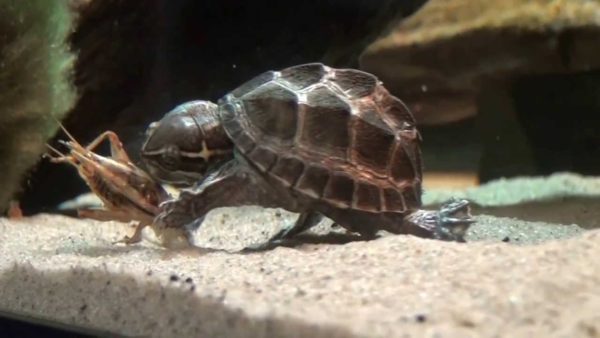
In the same aquarium with shellfish, you can breed fish. For turtles, experienced owners often breed guppies, due to their unpretentiousness and fertility. If fish live in the tank, snails do not need additional feeding.
If there is no food, you can catch frogs, tadpoles and land snails for the red-eared turtle. River snails can carry parasites, so feeding them to your pet is not recommended. Earthworms need to be dug away from the fields, as farmers can work the land for pests.
Home Blanks
You can make your own food for your pet. Snails are subject to freezing. To do this, they are rinsed and, without wiping, closed in a cold place in a container. The frozen moisture forms an ice crust, which contributes to long-term storage.
Gammarus, daphnia, coretra and bloodworms can be dried at home on their own. Gauze is pulled over a wooden frame. The structure is installed in a ventilated room, so as to ensure air circulation from above and below. It is advisable to choose a place away from sunlight. Raw materials are distributed over gauze in an even layer and kept until completely dry.
| Product | One can | Can be done in small quantities | Must not |
| Vegetables | Carrots | squash | Cabbage |
| Field lettuce (valerianella) | Cucumber | Potatoes | |
| Watercress | Iceberg lettuce | Sweet potato | |
| lettuce salad | Romaine lettuce | Spinach | |
| Pumpkin | Radish | ||
| Arugula salad | Turneps | ||
| Radish | |||
| Tomatoes | |||
| Asparagus | |||
| Eggplant | |||
| Bow | |||
| Garlic | |||
| Fruits and berries | Apple | Avocado | |
| Pear | Garnet | ||
| Apricot | Red currant | ||
| Watermelon | blackcurrant | ||
| Banana | Citrus fruits | ||
| Cherry | |||
| Melon | |||
| Kiwi | |||
| Raspberry | |||
| Strawberries | |||
| Mango | |||
| Greens | Dandelion | Beetroot | Azalea |
| Clover | Violet | Scheffler | |
| Tops of carrots | Geranium | Nightshade | |
| Plantain | Calendula | Hydrangea | |
| Sneep | Snapdragon | Rhododendron | |
| Osoka | Mallow | Lily | |
| Oat | Radish leaves | Cyclamen | |
| fescue | Jerusalem artichoke leaves | Mistletoe | |
| couch | turnip leaves | Lupine | |
| Wheat | Dill | Ficus | |
| Barley | Chayote leaves | Juniper | |
| Raspberry leaves | field mustard | Delphinium | |
| Warthog | strawberry | Lobelia | |
| Valerianella | Cardamine | Jasmin | |
| Cornflower | Blooming Sally | Milkweed | |
| Geranium | Claytonia | Narcissus | |
| field gerardia | Bloodroot | Periwinkle | |
| Bell | Bed room | Ipomoea | |
| Salsify | Podmarennik | Crocus | |
| Mordovia | Camomile | Lily of the valley | |
| Forget-me-nots | Ripe | Monstera | |
| rose flower | yearbook | Azalea | |
| Feverweed | Spiraea | Oleander | |
| Smyrna | Parsley | ||
| Umbilicus | Sagebrush | ||
| Millet | Poppy | ||
| Cortaderia | Linen | ||
| Echeveria | Sorrel | ||
| Meat | Feed mice | Mutton | |
| Beef liver | Pork | ||
| Chicken liver | Chicken | ||
| chicken heart | Beef | ||
| Turkey liver | Pork giblets | ||
| Lamb liver | Canned food | ||
| Sausages | |||
| Sausages | |||
| Fish | Alaska Pollock | Capelin | |
| Navaga | Herring | ||
| Hake | Mackerel | ||
| Kabmala | Sprat | ||
| Cod | Salaca | ||
| Halibut | |||
| Blue whiting | |||
| Trepang | |||
| Crucian | |||
| Bream | |||
| Navaga | |||
| Bleak | |||
| Guppy | |||
| Danio rerio | |||
| Algae and aquatic plants | Aponogeton | watercress, watercress | Bakola |
| Loosestrife | Pistia | Iris | |
| Kabomba | caroline duckweed | Rogulnik | |
| Hornwort | A series of tripartite | Reeds | |
| Peristolnik | Nedotroha | ||
| Mazus creeping | Eichornia elodea | ||
| Horsetail | |||
| Seafood | Daphnia | Gammarus raw | Squid |
| Crabs | Trumpeter | ||
| aquarium shrimp | Mussels | ||
| Crayfish | Octopus | ||
| Milk products | Any dairy product | ||
| Insects and molluscs | Earthworms | Tobacco hawk caterpillar | Oparysh |
| Grasshoppers | flour worm | amber snail | |
| locust | Zophobas | Luzhanki | |
| Fireflies | Woodlice | Ponds from the street | |
| marble cockroaches | Bloodworm | Slugs without a shell | |
| Turkmen cockroaches | garden snails | ||
| Ognyevka | grape snail | ||
| Lioness fly larvae | garden chain | ||
| Coils | forest snail | ||
| Ampullary | Karakolus | ||
| Helena | Achatina | ||
| Neretina | caviar caviar | ||
| Melania | |||
| Mariza | |||
| Brothia |
What to feed an aquatic turtle: the right diet for decorative aquarium turtles
3.1 (61.82%) 22 votes



